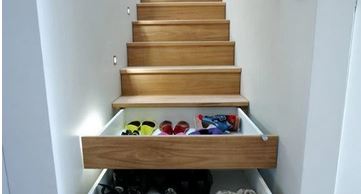Architects’ Top Tips
Storage is the word on everyone’s lips these days. OK, not everyone, but it’s a big deal if you’re in the process of designing a house, right? It’s a delicate balancing act – you want to make sure you have plenty of storage for your belongings, now and in the future, but not so much that you’re still hanging on to a shellsuit that might just come back into fashion, or a drumkit that you never really used but that your 2 year old might be glad of in 15 years? Plus, every square meter adds cost, so the last thing you want is an expensive dumping ground. Here are our best tips to help you get clever about storage.Firstly, channel Marie Kondo. If you’ve never heard of Marie Kondo, you’d better start listening. Marie Kondo is a Japanese guru of organisation, who wrote the definitive book on the subject, The Life-Changing Magic of Tidying Up. It’s a game-changer for all you hoarders out there, and if you haven’t got the time or will to go out and buy it, this is the main gist: Keep only those things that bring you joy and don’t be sucked in by nostalgia. She has a lot of other great tips too, but essentially, she urges us to only buy and hold on to things that we truly love. Steadfastly sticking to this rule alone should cut down on a lot of clutter. Keep less stuff, but keep better stuff

Now, that’s all well and good until you add children into the mix. Suddenly, you find your once pristinely organised living room full of singing plastic tricycles, and there’s an overflowing inflatable sandpit at the back door and a pink electric keyboard on the floor of the kitchen. Sadly, you can’t just give these items away to a more loving home because, firstly, they were all gifts from people who’d be really quite offended if they were to disappear, and secondly, your 4-year old is likely to declare that she simply can’t live without any of these marvellous items. So, while you can’t control everything, here are some good ways to plan your home for less mess, especially if you have children.

Mud room storage by Ana White, via ana-white.com
Bikes, scooters, sports equipment, and outdoor toys take up tons of space, and they’re usually dirty. A secure, covered, outdoor space to the side of your house is perfect for keeping bulkier bits, ideally with a connection to a mud-room or utility area where boots can be washed and wet coats hung to dry. This space can also accommodate space for washing pets and storing their paraphernalia. Allow plenty of hanging space for coats, racks for dirty shoes and boots, and hooks for school backpacks, all of which can be combined with a bench for putting on shoes.

walk-in linen cupboard by Betty Lou Phillips via derringhall.com
Now, in many homes, the utility or mudroom is combined with a laundry, so you might want to consider organizg a clean area for drying clothes adjacent to it, to allow a certain amount of distance between muddy sports gear and your clean white linens. Make sure you’ve got a decent sized airing cupboard for sheets and towels, ideally close to both the drying area and your bedrooms or stairs. We’re all familiar with those deep tardis-like airing cupboards from which you have to pull everything out to find a matching pillowcase. Consider a walk—in version like the one above, where everything can be easily organised and found at a glance.

in-stair shoe storage via howdoesshe.com
You may also like to keep a hidden coat and shoe storage area near your main front door. There are loads of brilliant storage solutions to make the most of the space under your stairs, so no excuses! Cupboards with pop-open doors can be incorporated throughout your home, and will simply melt against the walls. Architect John Pawson uses this storage feature in most of his home designs in order to retain a calm minimalist feel throughout. Key to a peaceful and ordered appearance is making sure that everything has its place, in or out of sight.

Minimalist storage by John Pawson via johnpawson.com

Minimalist storage by John Pawson via johnpawson.com
Every home needs space for those things that only get used occasionally, and there’s no point in pretending they don’t exist. Christmas tree decorations, suitcases, the surfboard you don’t get to use as much as you’d like, and even the carefully curated box of kids’ art that you just have to keep – it all needs a home. Attics are great for this, but be strict with yourself and don’t allow it to become a hoarder’s paradise – ask yourself if Marie Kondo would approve of whatever you’re keeping up there! Floor your attic and add shelves to keep it orderly.Deep built in benches or window seats can double up as great toy chests – they can house deep drawers underneath like the Melbourne home below (Melbourne House Photo by Tom Ross, Styling by Georgina Quinn), or can have seats that hinge upwards like a traditional toy chest (but do make sure you’ve installed soft close hinges to prevent injury to little fingers!). Similarly, deep drawers under beds can hold an enormity of kids’ things, and you can even try raising the bed much higher to become a loft style for older kids.

bed on cabinets via Bloesem.com (below)

Lastly, here’s our final tip: Disperse storage throughout your home, don’t just leave everything in one big dumping room. Homes for bigger items need to be designed in, like bikes, ironing boards, and even dog beds, so make sure you’ve got a detailed inventory and a space allocated for everything before you start building!



